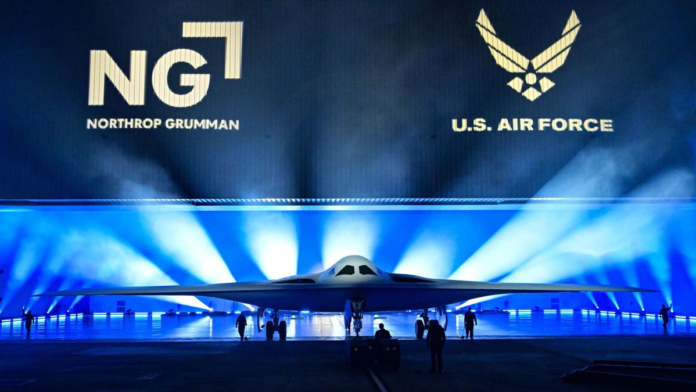The B-21 Raider stealth bomber, a sixth-generation bomber for the U.S. Air Force, is unveiled at Edwards Air Force Base, California on Dec. 2, 2022.
The U.S. Air Force has a new stealth bomber: Meet the B-21 Raider.
Officials with the U.S. Air Force and aerospace company Northrop Grumman unveiled the newest aircraft in the U.S. fleet late Friday (Dec. 2) in a ceremony webcast live online from the Edwards Air Force Base in California. The new bomber, built by Northrop Grumman, will be the backbone of the Air Force’s bomber fleet once it enters service in a few years. It will also offer the first look at what are sure to be next-generation aerospace capabilities that will likely become commonplace in decades to come.
“The B-21 Raider is the first strategic bomber in more than three decades,” U.S. Secretary of Defense Lloyd J. Austin said during the unveiling ceremony. “It is a testament to America’s enduring advantages in ingenuity and innovation. And it’s proof of the Department’s long-term commitment to building advanced capabilities that will fortify America’s ability to deter aggression, today and into the future.”
“This changes everything,” a promotional video played during the ceremony stated.
Related: The most dangerous space weapons ever
Northrop Grumman CEO and President Kathy Warden called the plane the “most capable stealth bomber ever built.”
“This next-generation aircraft defines what this nation is capable of when we work together,” Warden said. “We are opening a new era in technology for national defense digitally designed, enabled and maintained the B-21.”
The Air Force and Northrop Grumman revealed the B-21 Raider in dramatic fashion during the livestream, with the plane covered by a massive shroud that slid away as the bomber emerged from its hangar, backlit by blue light. The lighting of the aircraft during the ceremony kept many parts of the bomber hidden in shadow, but the futuristic, flying-saucer-like design was plain to see from the angle the public was allowed.
US Secretary of Defense Lloyd Austin speaks at the B-21 Raider unveiling ceremony at Northrop Grumman’s Air Force Plant 42 in Palmdale, California, December 2, 2022. (Image credit: FREDERIC J. BROWN/AFP via Getty Images)
Little is known about the actual capabilities and specifications of the B-21; nearly every aspect of the program is classified, according to the Associated Press (opens in new tab). Not even the aircraft’s exact wingspan is known, although judging from the size of the B-21’s landing gear as seen during the unveiling, it appears smaller than its predecessor, the B-2 Spirit (opens in new tab), which has a wingspan of 172 feet (52 meters).
The aircraft in the unveiling ceremony was only shown from the front; no views of the rear of the aircraft have been shown to the public. This means we know very little about the exhausts of its engines, which would give clues to its propulsion system and subsequently its flight capabilities. It also means don’t even know what the full silhouette, or planform, of the B-21 looks like.
As military aviation blog The War Zone points out (opens in new tab), there are no visible seams on the aircraft shown in the unveiling ceremony, possibly suggesting the B-21’s production featured sophisticated manufacturing techniques and new advanced materials that allow sensors, communication antennas and air data systems to be built directly into the airframe (the body of the aircraft excluding its power and propulsion systems). This would imply a massive revolution in terms of low observability (stealth), making the aircraft even harder to detect with radar and other sensors.
Related: X-37B: The Air Force’s mysterious space plane
The B-21 Raider stealth bomber under an evening sky at Edwards Air Force Base in California. (Image credit: U.S. Air Force)
While both Northrop Grumman and the Air Force have released fact sheets (opens in new tab) on the stealthy new jet, they are limited to broad generalities about the aircraft’s capabilities. “Developed with the next generation of stealth technology, advanced networking capabilities and an open systems architecture, the B-21 is optimized for the high-end threat environment,” the manufacturer’s fact sheet (opens in new tab) reads.
What is known is that the B-21 can be operated in either crewed or uncrewed configurations, and is equipped to carry both conventional and nuclear munitions. The aircraft was designed with what is known as an “open systems architecture,” meaning it can be quickly upgraded with new capabilities and subsystems as they develop.
It is also known that the B-21 Raider costs $692 million for each aircraft. Over the next three decades, the program is expected to cost United States taxpayers $203 billion, according to a Time exclusive (opens in new tab). The Air Force has stated it seeks an inventory of a minimum of 100 (opens in new tab) B-21 Raiders.
The B-21 Raider stealth bomber unveiled by the U.S. Air Force on Dec. 2, 2022. (Image credit: U.S. Air Force)
The first flight of the B-21 isn’t expected until 2023. Six models are currently in various stages of final development at Northrop Grumman’s facility in Palmdale, California. The aircraft shown at the tightly-controlled unveiling ceremony on Friday (Dec. 2) will be first used for ground testing of its engines and subsystems before any of the advanced bombers take to the sky.



